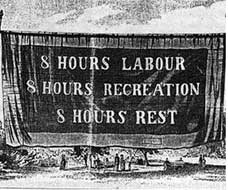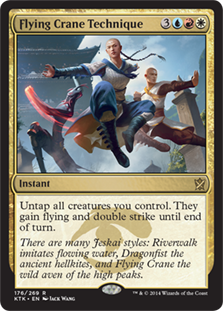Editor’s Note: We’re off today in celebration of the holiday. In the meantime, enjoy this historically relevant Monday Magic article about why we’re taking it off in the first place, which was originally published on 8/31/15.
Next Monday marks the celebration of Labor Day in the United States, a national holiday whose purpose is to honor the workers of the country. We’ve come to treasure this day off (in theory) as a testament to the work the average laborers of the country put forth day after day. It’s a way to symbolically tip our hats to the efforts of the often-overlooked and perennially under-appreciated common folk who help keep things maintained and prosperous.
This isn’t an idea unique to the US. In truth, most countries of the world have a Labor Day. The vast majority of them celebrate International Labor Day or May Day, in, well, May. They do so in commemoration of the Haymarket Riots of 1886 – an event that took place in Chicago. It’d be more ironic that an international holiday is in reference to an American event while the US doesn’t if it wasn’t something we did deliberately.
 See, the Haymarket affair was a highly volatile, highly political incident whose repercussions are still being felt today – even if most people haven’t heard of it. During this period in history there was a lot of unrest in the workplace. Thanks to the Industrial Revolution, the railroad, and a whole bunch of other innovations, the country quickly was moving from an agrarian to industrialized country.
See, the Haymarket affair was a highly volatile, highly political incident whose repercussions are still being felt today – even if most people haven’t heard of it. During this period in history there was a lot of unrest in the workplace. Thanks to the Industrial Revolution, the railroad, and a whole bunch of other innovations, the country quickly was moving from an agrarian to industrialized country.
This led to surges in technology and productivity, but people were still oddly expected to put in the same amount of hours each week as one would have on farms: 10-12 hour days, six days a week. Eventually people got wise to the idea that what may work for a farm schedule hardly works the same in an office or a machine shop. So around this time, spurned on by the rise in labor unions and left-leaning political groups, a radical idea in the workplace began picking up steam – the 8 hour work day.
For the same reasons we’re likely to hear in our workplaces today, management refused. Conflicts arose. The most famous of this was the 1886 Haymarket Riots, when a group of people striking for an 8-hour day were trying to be dispersed by police and someone in favor of total anarchy threw a bomb at the police. It worked. The police, unsure where it came from, fired on the crowd of workers. Dozens were either killed or wounded. The strikers were ultimately blamed for the violence, but while public opinion turned against them in the short term, it also marked a turning point for the labor movement.
Within five years, an international effort established May Day. While some states and cities also began to adopt Labor Day on their own, in typical fashion the US on a national level did not join in. It took ten years after Chicago, the depression of the 1890s, and a series of other notable strikes to finally get Labor Day as a US national holiday. Even then, the President at the time believed aligning Labor Day with May Day and the Haymarket incident would be a bad idea. Instead he opted to align the date with a New York labor parade. That parade itself was inspired by a local labor celebration in Toronto going on since the 1880s in celebration of a union there striking to get down to a 50-something hour work week.
Thus, this is why the US and Canada have Labor Day in September, and why most Americans outside of a history schoolbook don’t remember Haymarket.
So, how does this all factor into Commander? Why it all goes back to the anarchist with the bomb.
As it happens, my original pick for this week’s article was going to be Narset, Enlightened Master. Narset seemed a solid choice at first: she fit my playful Red, White, and Blue color scheme, she’s inexpensive to acquire, and she seemed like an interesting confluence of effects that warranted sharing. I largely avoid showcasing cards in the Commander spot, but Narset seemed like a worthwhile card that would be fun exploring.
Then came the dynamite.
Unbeknownst to me at the time, Narset has garnered a reputation in certain EDH spheres as a problematic Commander. Or, rather, that a subset of people use Narset as a Commander and can’t resist absolutely breaking her. (See also: Lesson Two of What Not To Do In EDH.) This group relies on having a very aggressive Narset deck build, utilizing fast mana drops to get her out quickly (in some cases even using super-broken Lion’s Eye Diamond or similar cards to get a turn one cast of a six-cost Commander). Then, they load the deck up with similarly aggressive cards to proc off her ability such as Armageddon-esque land destruction, extra turn cards like Beacon of Tomorrows, and cards like Enter the Infinite to play whatever else they want as they combo into an unstoppable win.
I don’t blame the card; a six-cost General isn’t supposed to come out on turn one. Or two. or three. Her free spell effect plus hexproof makes an early appearance too difficult to handle for most people, and utilizing her like that makes her simply not fun to play against. I felt set back by my decision, as I firmly believe Narset can be a fun casual general without being broken, but knowing that many people have little restraint in the face of such temptation, I decided to scrap her as my card of choice.
So we’re going to try a different Labor Day homage instead.
Today we have: Flying Crane Technique

Name: Flying Crane Technique
Edition: Khans of Tarkir
Rarity: Rare
Focus: Creature Control / Combat Control
Highlights: There’s an old aphorism that a rising tide lifts all boats. The implication is that, assuming all things are equal, everyone involved will benefit equally when the environment you’re part of prospers. In the classic sense, it refers to economic progress.
Here though, it’s all about your creatures. Because it can be played practically at any time, when used correctly Flying Crane Technique is suitable whether you’re holding the defenses or rising out the trenches for an assault on your opponent.
In many ways Flying Crane Technique possesses the same vibe as the Alara ultimatums, albeit with a slightly different tact. In the case of this card, it’s slightly cheaper and can be cast as an Instant, giving it a coveted dual purpose. Using it to go on the attack can be a potentially game-ending move with a decent army at your back, effectively doubling all of your creatures’ power and making them much harder to block. What’s more, if you time the casting of the card until right after you declare attackers, you’re also able to take advantage of untapping them. With Flying, de facto Vigilance, and Double Strike all at your disposal, striking with even a handful of moderately sized creatures could cripple if not outright eliminate an opponent at little to no danger of leaving yourself open to a counterstroke should they survive.
On the other side of the coin, Flying Crane Technique can be used as a surprise defensive trap. Not only does this untap all your creatures so you can block, it gives you a fighting chance against a decent size attack, let alone flyers. Using it on the defense is probably not as ideal to some since FTC is not a cheap card (especially for an Instant). Coming in at six mana and requiring three different colors is a heavy investment for anyone intending to sit on it as a combat trick. Still, the option certainly is available to you in the later stages of the game when such a move could swing the balance of power in your favor after they run into a surprise pummeling.
Lastly, as a third but even more cost prohibitive option, you’re able to use this in noncombat situations like, say, having reason to untap all of your creatures. It’s an expensive prospect, but there are certainly times in EDH you may want to untap a potent creature or two on your battlefield in response to a player doing something you may or may not like. This option forgoes the combat-based benefits, but it is yet another option the card provides in a pinch.
Yes, while Flying Crane Technique requires creatures in general and is not as useful in the early to middle stages of the game, it can be devastating the further along the game goes. With the right mana investment, and using those resources properly, this card can easily get the job done at taking down or taking out an enemy.
For that kind of mana cost, let it do the work for you. We may not have gotten a national 40 hour week and weekends until 1940, but in Commander take any moment of reprieve you can, however fleeting. Chances are your next task will provide a whole new set of challenges.
Keep an eye out for us to be regularly featuring other more accessible-but-worth-it Commander cards going forward. In the meantime, we’ll keep the light on for you.
![]()
You can discuss this article over on our social media!
Do you have a particular Commander card to suggest for us to shine a future Spotlight on? You can send suggestions to ryan@cardboardrepublic.com
